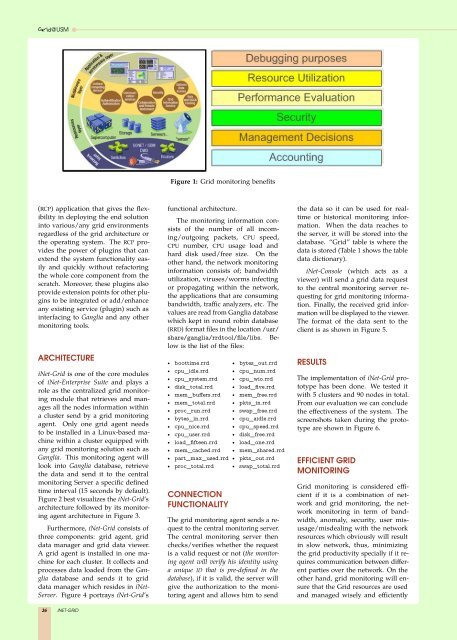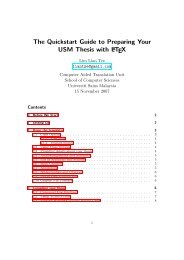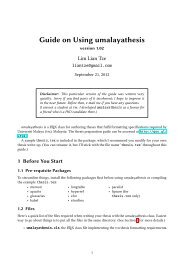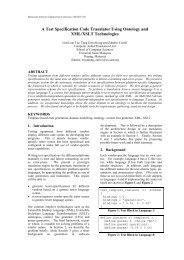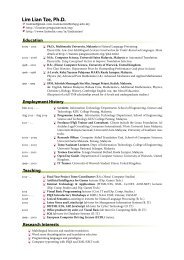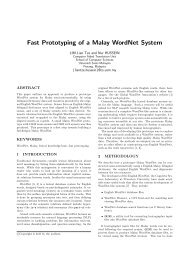Grid Computing Cluster â the Development and ... - Lim Lian Tze
Grid Computing Cluster â the Development and ... - Lim Lian Tze
Grid Computing Cluster â the Development and ... - Lim Lian Tze
You also want an ePaper? Increase the reach of your titles
YUMPU automatically turns print PDFs into web optimized ePapers that Google loves.
<strong>Grid</strong>@USMFigure 1: <strong>Grid</strong> monitoring benefits(RCP) application that gives <strong>the</strong> flexibilityin deploying <strong>the</strong> end solutioninto various/any grid environmentsregardless of <strong>the</strong> grid architecture or<strong>the</strong> operating system. The RCP provides<strong>the</strong> power of plugins that canextend <strong>the</strong> system functionality easily<strong>and</strong> quickly without refactoring<strong>the</strong> whole core component from <strong>the</strong>scratch. Moreover, <strong>the</strong>se plugins alsoprovide extension points for o<strong>the</strong>r pluginsto be integrated or add/enhanceany existing service (plugin) such asinterfacing to Ganglia <strong>and</strong> any o<strong>the</strong>rmonitoring tools.ARCHITECTUREiNet-<strong>Grid</strong> is one of <strong>the</strong> core modulesof iNet-Enterprise Suite <strong>and</strong> plays arole as <strong>the</strong> centralized grid monitoringmodule that retrieves <strong>and</strong> managesall <strong>the</strong> nodes information withina cluster send by a grid monitoringagent. Only one grid agent needsto be installed in a Linux-based machinewithin a cluster equipped withany grid monitoring solution such asGanglia. This monitoring agent willlook into Ganglia database, retrieve<strong>the</strong> data <strong>and</strong> send it to <strong>the</strong> centralmonitoring Server a specific definedtime interval (15 seconds by default).Figure 2 best visualizes <strong>the</strong> iNet-<strong>Grid</strong>’sarchitecture followed by its monitoringagent architecture in Figure 3.Fur<strong>the</strong>rmore, iNet-<strong>Grid</strong> consists ofthree components: grid agent, griddata manager <strong>and</strong> grid data viewer.A grid agent is installed in one machinefor each cluster. It collects <strong>and</strong>processes data loaded from <strong>the</strong> Gangliadatabase <strong>and</strong> sends it to griddata manager which resides in iNet-Server. Figure 4 portrays iNet-<strong>Grid</strong>’sfunctional architecture.The monitoring information consistsof <strong>the</strong> number of all incoming/outgoingpackets, CPU speed,CPU number, CPU usage load <strong>and</strong>hard disk used/free size. On <strong>the</strong>o<strong>the</strong>r h<strong>and</strong>, <strong>the</strong> network monitoringinformation consists of; b<strong>and</strong>widthutilization, viruses/worms infectingor propagating within <strong>the</strong> network,<strong>the</strong> applications that are consumingb<strong>and</strong>width, traffic analyzers, etc. Thevalues are read from Ganglia databasewhich kept in round robin database(RRD) format files in <strong>the</strong> location /usr/share/ganglia/rrdtool/file/libs. Belowis <strong>the</strong> list of <strong>the</strong> files:• boottime.rrd • bytes_out.rrd• cpu_idle.rrd • cpu_num.rrd• cpu_system.rrd • cpu_wio.rrd• disk_total.rrd • load_five.rrd• mem_buffers.rrd • mem_free.rrd• mem_total.rrd • pkts_in.rrd• proc_run.rrd • swap_free.rrd• bytes_in.rrd • cpu_aidle.rrd• cpu_nice.rrd • cpu_speed.rrd• cpu_user.rrd • disk_free.rrd• load_fifteen.rrd • load_one.rrd• mem_cached.rrd • mem_shared.rrd• part_max_used.rrd • pkts_out.rrd• proc_total.rrd • swap_total.rrdCONNECTIONFUNCTIONALITYThe grid monitoring agent sends a requestto <strong>the</strong> central monitoring server.The central monitoring server <strong>the</strong>nchecks/verifies whe<strong>the</strong>r <strong>the</strong> requestis a valid request or not (<strong>the</strong> monitoringagent will verify his identity usinga unique ID that is pre-defined in <strong>the</strong>database), if it is valid, <strong>the</strong> server willgive <strong>the</strong> authorization to <strong>the</strong> monitoringagent <strong>and</strong> allows him to send<strong>the</strong> data so it can be used for realtimeor historical monitoring information.When <strong>the</strong> data reaches to<strong>the</strong> server, it will be stored into <strong>the</strong>database. “<strong>Grid</strong>” table is where <strong>the</strong>data is stored (Table 1 shows <strong>the</strong> tabledata dictionary).iNet-Console (which acts as aviewer) will send a grid data requestto <strong>the</strong> central monitoring server requestingfor grid monitoring information.Finally, <strong>the</strong> received grid informationwill be displayed to <strong>the</strong> viewer.The format of <strong>the</strong> data sent to <strong>the</strong>client is as shown in Figure 5.RESULTSThe implementation of iNet-<strong>Grid</strong> prototypehas been done. We tested itwith 5 clusters <strong>and</strong> 90 nodes in total.From our evaluation we can conclude<strong>the</strong> effectiveness of <strong>the</strong> system. Thescreenshots taken during <strong>the</strong> prototypeare shown in Figure 6.EFFICIENT GRIDMONITORING<strong>Grid</strong> monitoring is considered efficientif it is a combination of network<strong>and</strong> grid monitoring, <strong>the</strong> networkmonitoring in term of b<strong>and</strong>width,anomaly, security, user misusage/misdealingwith <strong>the</strong> networkresources which obviously will resultin slow network, thus, minimizing<strong>the</strong> grid productivity specially if it requirescommunication between differentparties over <strong>the</strong> network. On <strong>the</strong>o<strong>the</strong>r h<strong>and</strong>, grid monitoring will ensurethat <strong>the</strong> <strong>Grid</strong> resources are used<strong>and</strong> managed wisely <strong>and</strong> efficiently36 INET-GRID


